Download Bubble Shooter MOD 2025
*Bubble Shooter* is a match-3 puzzle game developed and published by Ilyon Dynamics Ltd. Based on the 1994 arcade game *Puzzle Bobble*, its key concept requires the player to clear a playing field of bubbles. Players control a cannon to shoot a colored bubble, aiming to form a group of three or more of the same color. A successful match causes the corresponding cluster to pop and disappear. The game is lost if the descending mass of bubbles reaches the bottom of the screen before the field is cleared.
Game Visuals
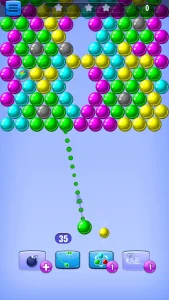
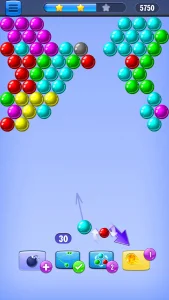
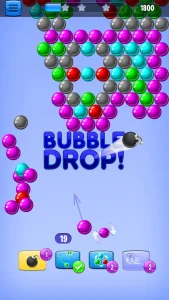
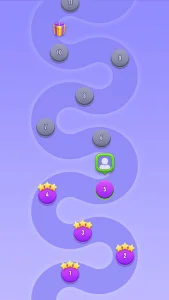
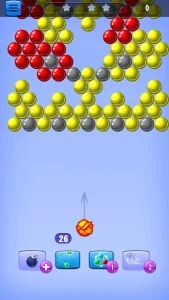
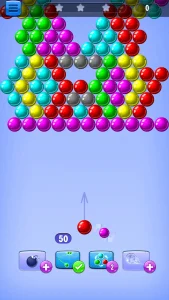
Description
An Analytical Overview of Bubble Shooter
Bubble Shooter represents a foundational title within the casual puzzle game genre, a timeless classic whose simple mechanics conceal a rich history and a sophisticated modern structure. This analysis explores the game's core components, from its developmental lineage and gameplay mechanics to its technical requirements and monetization framework. The intellectual property (IP), currently published by Ilyon Dynamics Ltd., has evolved significantly from its origins as a web-based pastime into a major mobile franchise available across a multitude of platforms, including Android and iOS.Foundational Identity and Development History
Developer and Publisher Lineage
The stewardship of the Bubble Shooter IP illustrates its journey through the digital gaming landscape. The original version of the game was developed by Absolutist LTD, a Ukrainian studio that released the title in 2002, establishing the gameplay formula that would achieve global recognition. A pivotal moment in the game's history occurred in 2015 when Ilyon Dynamics Ltd., an Israeli mobile game studio, acquired the Bubble Shooter IP. This transaction transferred control of the brand, its user base, and its market presence to Ilyon, who has since managed its development and publication. Following the acquisition, Ilyon's strategy expanded beyond maintenance, pushing the IP into new ecosystems like Facebook Messenger and the real-money eSports platform Skillz.Genre Classification and Arcade Origins
Bubble Shooter is classified within several overlapping gaming genres, including Puzzle, Casual, and Match-3. Its core design, however, makes it a prominent member of the eponymous Bubble Shooter genre. The gameplay concept is not an original invention but a highly successful clone of Taito's 1994 arcade game, Puzzle Bobble, which was known in Western markets as Bust-a-Move. Taito's Puzzle Bobble was itself a spin-off of the iconic 1986 title Bubble Bobble. This lineage, rooted in the golden age of arcade gaming, provides the basis for its intuitive and universally appealing mechanics.Release Timeline and Platform Proliferation
The game's history showcases its adaptation from early internet gaming to the contemporary mobile era. After its initial 2002 release by Absolutist, the game was ported to iOS in 2010 and subsequently to Android in 2012. Its simple mechanics have facilitated its availability on a wide array of platforms, including modern Android and iOS devices, web browsers via HTML5, Mac OS, and integrated Facebook applications.Core Gameplay Mechanics and Player Controls
The Fundamental Gameplay Loop
The enduring appeal of Bubble Shooter originates from its profoundly addictive core gameplay loop. The primary objective requires the player to clear the entire playing field by forming groups of three or more bubbles of the same color. A player controls a cannon at the bottom of the screen, aiming and firing colored bubbles into the cluster above. The game is lost if the descending mass of bubbles reaches the bottom boundary of the play area. Strategic planning is supported by a preview system that displays the next one or two bubbles to be loaded, allowing for advanced tactical decisions.Key Strategic Mechanics
Beyond the basic loop, several mechanics define the game's strategic depth and challenge. Mastering these elements is crucial for clearing levels efficiently and achieving high scores.- The Pop: The most basic action, where a fired bubble connects with at least two other bubbles of the same color, causing the matched group to be removed from the board.
- The Drop (Avalanche): A critical strategic element where popping a cluster of bubbles causes any other bubbles attached only to that group to detach and fall. This technique clears large sections of the board and yields significant point bonuses.
- The Penalty System: A core tension-building mechanic. When a player fires a bubble that fails to create a match (a "miss"), it contributes to a foul limit. After a set number of misses, the game adds one or two new rows of bubbles from the top, increasing the pressure and difficulty.
- Bank Shots: An advanced technique where players bounce bubbles off the side walls to reach clusters that are blocked from a direct line of fire. This skill is essential for solving complex puzzles in later levels.
Intuitive Control Schemes
The control system is designed for maximum accessibility across different platforms. On mobile devices with touchscreens, players tap and drag to position an aiming guideline and release their finger to fire the bubble. On web-based versions, the mouse cursor is used to aim, and a single left-click executes the shot.Exploring the Different Game Modes
Classic Mode: The Endless Challenge
Classic Mode offers the original, quintessential Bubble Shooter experience. It is an untimed, score-focused mode where the objective is to clear the board and achieve the highest score possible. Modern iterations of this mode incorporate the penalty system, where a new row of bubbles is added after a specified number of non-popping shots. This mode tests a player's endurance, precision, and long-term strategic planning.Arcade Mode: A Modern Puzzle Progression
Arcade Mode, also known as Levels Mode, constitutes the core of the modern mobile game. Players progress through a map of thousands of handcrafted levels, each presenting a unique puzzle with a specific objective. These objectives may include clearing all bubbles, rescuing trapped characters, or clearing the top of the screen within a limited number of shots. This mode's structure is intrinsically linked to the free-to-play business model, creating a long-term engagement loop and allowing for the implementation of difficult "gatekeeper" levels that encourage the use of purchasable power-ups.Competitive and Specialized Modes
Certain versions of the game feature specialized modes. Sniper Mode is an older variant that challenges players to clear the board using the fewest possible shots, prioritizing efficiency over high scores. A more recent evolution is the Tournaments Mode, found in apps integrated with the Skillz eSports platform. Here, players compete against others in timed matches to achieve the highest score, with all participants receiving the identical board layout and bubble sequence to ensure a contest of pure skill.Technical Specifications for Mobile Installation
System Requirements for Android and iOS
Bubble Shooter maintains low technical requirements, ensuring accessibility for a broad range of devices. For Android, recent versions of the game often require Android 5.0 (Lollipop) or higher, with a recommendation of at least 2 GB of RAM for smooth performance. Storage requirements typically range from 50 MB to 110 MB. For iOS, the latest versions necessitate iOS 15.5 or later and require approximately 224.1 MB of storage space.Internet Connectivity and Offline Capabilities
The core gameplay of both Classic and Arcade modes is fully playable offline, requiring no constant internet or Wi-Fi connection. However, an online connection is necessary for certain features, including downloading the game and updates, collecting daily rewards, viewing leaderboards, participating in online tournaments, making in-app purchases, and watching rewarded video advertisements for bonuses.A Guide for APK Installation and Troubleshooting
Understanding APK and XAPK File Formats
For users installing the game outside of the official Google Play Store, it is vital to understand the file formats. An APK (Android Package Kit) is the standard format for Android apps. Some third-party sources distribute the game as an XAPK, a non-standard package that bundles the main APK file with an essential OBB (Opaque Binary Blob) file. This OBB file contains large assets like graphics and level data and is mandatory for the game to launch correctly.Step-by-Step Installation Process
Installing an XAPK file requires a specific procedure. First, the user must enable the "Install unknown apps" permission in their device settings. The recommended method is to use a dedicated XAPK installer or a file manager that automatically handles the process, which involves installing the APK and correctly placing the OBB file in the `Android/obb/` directory. Manual installation is also possible by renaming the .xapk to .zip, extracting its contents, copying the obb folder to the correct path, and then installing the .apk file.Resolving Common Installation Errors
Users may encounter issues such as an "App not installed" error, which can result from insufficient storage, a corrupted file, or a CPU incompatibility. Game crashes on startup are often a symptom of a missing or incorrectly placed OBB file. Restarting the device and ensuring the OBB file is in the correct location are the primary troubleshooting steps.The Free-to-Play Monetization Strategy
Advertisements and In-App Purchases
Bubble Shooter operates on a standard free-to-play (F2P) model, generating revenue through advertisements and in-app purchases (IAPs). The game features full-screen interstitial ads between levels and optional rewarded video ads that players can watch for bonuses like extra moves or power-ups. The IAP economy revolves around a premium currency (coins) used to purchase power-ups like the Fireball or Bomb, or to buy extra moves to complete a difficult level. While the game is marketed as a relaxing experience, its design incorporates significant difficulty spikes in later levels. This structure can create frustration, thereby incentivizing players to make purchases to bypass these challenges and restore the initial sense of enjoyable progression.An Analytical Guide to Bubble Shooter Gameplay
Bubble Shooter is a foundational title in the casual puzzle game genre. The game’s core experience derives from the simple yet strategic mechanics of the match-3 puzzle format. Players engage with a system of colored bubbles, where the primary objective involves clearing a playing field by forming groups of matching colors. The game’s design, inherited from arcade classics like Puzzle Bobble, provides an accessible entry point for new players while offering significant strategic depth for experienced users. This guide analyzes the game’s mechanics, modes, and core strategies to provide a comprehensive understanding of its gameplay.
Core Gameplay Mechanics and Systems
The gameplay of Bubble Shooter revolves around a simple and addictive loop. The player controls a cannon positioned at the bottom of the screen. This cannon fires colored bubbles towards a large cluster of bubbles at the top. The fundamental goal requires the player to clear the entire playing field of these bubbles. Success in this task prevents the descending mass of bubbles from reaching the bottom line of the screen, which would otherwise result in a loss. Strategic planning is facilitated by a preview system that displays the next bubble to be loaded into the cannon, allowing players to anticipate future moves.
Key Strategic Elements
Several distinct mechanics define the strategic landscape of Bubble Shooter. The most basic action is the “Pop,” where a player’s fired bubble connects with two or more bubbles of the same color. This connection causes the entire matching group to be removed from the board. A more advanced and critical mechanic is the “Drop,” also known as an “Avalanche.” This event occurs when a player pops a cluster of bubbles that supports other, non-matching bubbles below it. The removal of the supporting cluster causes all attached bubbles to detach and fall, clearing large sections of the board efficiently. This action awards significantly more points and is central to effective play.
The game introduces tension through its penalty system. A player’s shot that fails to create a match is considered a “foul” or a “miss.” The game tracks these misses against a predetermined limit. Upon reaching this limit, the system penalizes the player by adding one or two new rows of bubbles from the top of the screen. This mechanic punishes inaccurate shots and poor planning, creating a negative feedback loop that increases the game’s difficulty and forces players to think critically about every action.
Advanced play necessitates the mastery of “Bank Shots.” Players can aim their bubbles at the side walls of the playing area. The bubble then ricochets off the wall at an angle, enabling players to hit bubble clusters that are otherwise blocked by frontal obstacles. This skill is essential for solving complex puzzles and achieving higher levels of performance.
Exploration of Game Modes
Bubble Shooter offers distinct game modes that cater to different play styles and objectives. These modes have evolved from the game’s origins as a simple web-based challenge into a structured mobile experience with thousands of unique levels.
Classic Mode
Classic Mode represents the original, quintessential Bubble Shooter experience. This mode presents players with an untimed, score-focused challenge. The objective is to clear the board and achieve the highest possible score before the descending wall of bubbles reaches the bottom. It functions as an endurance test that emphasizes long-term planning and precision. The core challenge in modern versions is managed by the penalty system, where a set number of non-popping shots adds new rows from the top, increasing pressure over time.
Arcade Mode
Arcade Mode is the primary gameplay experience in modern mobile versions. Players progress through a vast map containing thousands of handcrafted levels. Each level is a unique puzzle with a specific board layout and a distinct objective. These objectives vary from clearing all bubbles to rescuing trapped characters or clearing the top of the screen within a limited number of shots. This mode introduces new mechanics and obstacles as players advance, such as indestructible stone bubbles or bubbles encased in ice, which require specific strategies to overcome.
Mastering Controls and Basic Play
The control scheme in Bubble Shooter is designed for intuitive interaction across all platforms. On mobile devices with touchscreens, players tap and drag on the screen to manipulate a laser-like aiming guide. Releasing their finger fires the bubble toward the targeted location. On web-based platforms, the player uses the mouse cursor to aim the cannon’s pointer, and a single left-click executes the shot. This simplicity ensures the game remains accessible to a broad audience.
A Step-by-Step Guide for Beginners
- Understand the Primary Mission: Your central goal is to remove every bubble from the screen. Players accomplish this by firing a bubble from the cannon to form a connected group of three or more bubbles of the same color, causing them to pop.
- Practice Aiming and Firing: On a mobile device, touch and drag your finger on the screen to aim the guideline. Lift your finger to launch the bubble. This basic action is the foundation of all gameplay.
- Utilize the Bubble Preview: The game displays the next bubble that will enter your cannon. This information allows for forward planning. Players can use their current bubble to set up a better shot for the subsequent one.
- Prioritize High-Value Shots: Scan the board for immediate matches of two or more bubbles that match your current projectile. If no direct match exists, use your shot to create a pair of bubbles, preparing a future pop.
- Avoid Wasted Shots: The penalty system punishes consecutive non-popping shots by adding new rows. Ensure every shot serves a purpose, whether it is to pop a cluster or to set up a future move.
- Learn the Bank Shot: Shooting bubbles at the side walls causes them to bounce. This technique is a crucial skill for reaching bubbles that are blocked from direct access.
- Clear the Board to Win: Continue making matches and clearing the screen. In Arcade Mode, successfully clearing the board of all bubbles completes the level and unlocks the next challenge.
Advanced Strategies and Power-Up Utilization
Mastery of Bubble Shooter requires players to move beyond basic matching and employ advanced strategic thinking. Effective use of the game’s mechanics and special power-ups is essential for clearing difficult levels and achieving high scores. Patience is a key asset; the game rewards careful analysis over rushed, imprecise actions.
Tips for High-Level Play
- Prioritize Avalanches: The most efficient way to clear the board is by dropping large clusters of bubbles. Players should always scan the board to identify the highest bubble in a color chain. Popping that key cluster will detach everything connected below it.
- Create Vertical Gaps: Focusing on clearing entire vertical columns, rather than horizontal rows, can be highly effective. This strategy exposes more of the side walls, opening new pathways for powerful bank shots.
- Plan Two Moves Ahead: Superior strategy involves considering both the current bubble and the next one in the queue. This foresight allows for sophisticated maneuvers, such as using a less useful bubble to clear a path for a perfect shot with the next one.
- Use Strategic Waste Shots: If the cannon loads a color with no viable matches, firing it randomly can block future opportunities. Players should instead find a safe area on the board to tuck the bubble away where it will not cause interference.
Earning and Using Power-Ups
Players can earn powerful boosters through skillful gameplay. The Fireball is a power-up earned by popping seven bubbles consecutively. This booster plows through any bubbles in its path, allowing players to clear a direct line to a critical cluster. The Bomb is another power-up, earned by dropping ten or more bubbles in a single shot. This item clears a large circular area around its point of impact, making it ideal for eliminating dense, multi-colored clusters that are otherwise difficult to remove through normal matching.
